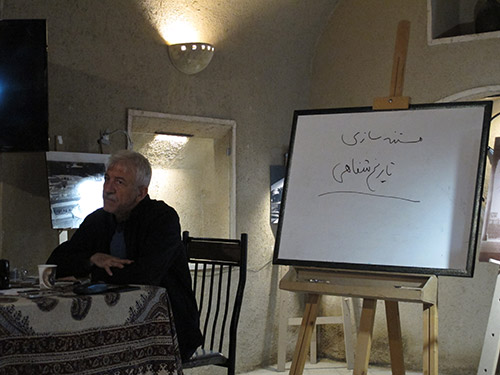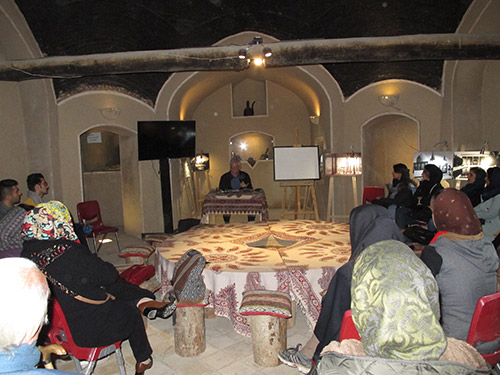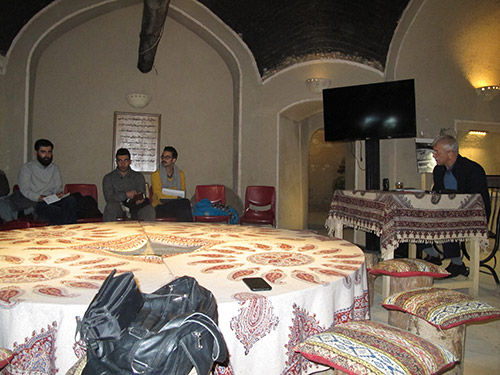"Application of Oral History in Video Documentation" Workshop
Oral history does not produce a document, it produces a documentary
Maryam Asadi Jafari
Translated by Natalie Haghverdian
2019-3-5
According to the Oral History website of Iran, a one-day workshop on "The Application of Oral History in Video Documentation" was held on Wednesday, February 13, 2019 by Dr. Morteza Nouraei, a professor at the University of Isfahan, and the efforts of Assarkhaneh Shahi Museum (Isfahan Community Studies Center) for interested beneficiaries. A compilation of the discussions is presented below.
Literature; documentation basis
In the first part of the workshop, Dr. Nouri introduced the documentation and oral history as two interdisciplinary categories and added: "My speech today on documentation will have a historical glaze. Also, I think of interdisciplinary categories as a potential for entrepreneurship and I think that today we have to enter into discussions which have the capacity to produce labor. When we use the word "documentation" in its general form, it might develop different perspectives and perceptions. But technically, when the word "documentary" or "citation" comes up, it is a phenomenon that relies on a document. "Document" is also inherently a written literature, that is, what is written and independent of its production origin- that no one can modify or change it. What is continually changing is not a document. In historical discussions, it is said that "terminology" is preferred by documentary scholars of history. But coins, carpets, architectural lines and ... are among the documents that are referred to as "relics". But the first preference is the "written" document, even if it is inaccurate or false. So documentary is based on written literature. In addition to the fact that the oral history phenomenon is based on the mind and memory, reviewing and revising it by interview, oral history is a phenomenon inherently reliant on documents. That is, until it is authenticated and screened by documents, it cannot have an independent life. So if you want to document any phenomenon, you'll be more and more involved with libraries and archives. "

Documentation Functions: Awareness and Skills
"The documentation process is like opening a compact spring," he added. Documentation is not a special and small transverse phenomenon. In the first step, we have to have a clear image of documentation, find important and interesting topic and content. So, according to the capacity of the subject, we have to draw a path (perspective) and its trajectory should be seen in the documentation. The background of documentary production requires studying. Therefore, the technical documentary producer must have the necessary studies on the subject. The content specifies the path to the research. Documentary producer is a researcher. It is strongly recommended that you consider your favorite topics. The word “Process” means the start of a trajectory to the end. This process in documentation is step-by-step and its perspective should be clearly designed. Awareness, creating skills, indirect teaching and practice are functions of a documentation. A documentary might be produced for children on a topic for their future to promote skills in them. The trajectories of documentation might subconsciously – wanted or unwanted- vary. For example, a documentary might be produced to address faulty traffic culture. In this case, the issue is multifaceted and requires a geometric road map. In light of this, documentary is a compound work and requires the attention to different aspects such as driving, passengers, private and public vehicles, streets, and so on.
Undoubtedly, documentation is a team work. One of the bases for documentation is a collective of two or three individual. From technical works such as finding resources and documents to library studies and pursuing field activities. Someone might also be the illustrator. It should be noted that for documentation, we have an internal and an external team; the internal team includes people who plan and take into consideration the geography, region, documents, and archives. In fact, this group is responsible for intellectual and operational affairs, and the other part is external. They should find people to interview. So, internal team does the planning, and, based on the scenario, are effective in recording and illustration of the project. External team includes people who are indirectly involved and the information and narrative content are derived from them.

Footnote free historiography
Footnote free historiography is in fact the entry of historical content in the field of documentation and a synthesis of the history and process of documentation. That is, when we make a documentary, how is it validated or believed by the audience? How and why is this documentary accepted? How is it authenticated?
In fact, when reading a text, in order to validate it, we refer to its references to see if the key resources are credible and useful. But when it comes to a video documentary, how should the audience believe it? How is it verified? To this end, several points are noted by which the circle of audience is brought to trust. This trust promotes interest. One of the important points is that there are facts that form the foundations of common beliefs. For example, a knowledgeable and credible person who narrates and plays a major role in the interview, or at the same time, an environment depicted that is the site of the incident. This is the first "footnote" that someone works on to be trusted by the audience or even the scientific community.
If you are documenting, you have to pay attention to the external spectrum involved in the production of information. This range includes individuals and resources. The role of the people who are supposed to be involved in this documentary must be clear – including the internal and external individuals and the interviewee, as well as the spectrum of the audience; what is the age group, the cultural-scientific level of production and learning of the audience? It is important that you understand the audience and produce a documentary for them. The audience group is one of the most important issues in documentation.
Another important point is time. We know that it takes a long time to collect relevant content. That is, if we are to make one minute documentary, it may require hours of concentrated work - apart from marginal studies. The common taste changes very quickly. That is, it may be important when starting a documentary, but when it finishes, it "falls off". Time pace is very important. Today, the oral history market is strong in the world. Moreover, it has found a way to attract public taste. The science of history documents and this documentation is cultural, social, and economic. Any documentary is historical. Even the nature's documentaries are a record of a region.
In the documentary, we evaluate the public interest. It doesn’t mean that we make documentaries based on the public interest. Various topics are discussed based on their potential.
The science of history has experienced a great deal of transformation and has many schools; those who are doubtful about the production of history or the group without any doubt about their own history. But, in any event one I can provide one fundamental definition of history. Because it is related to oral history and documentation, it is the most effective definition in understanding history, and as a result, the transformations of history are influenced by this definition: "the endless conversation of the past and present."

Oral history does not produce document!
Dr. Morteza Nouraee, in the second part of the workshop stated: "Conversation is the soul of oral history. This definition shows which part of the past we want to have dialogue with? Why do we maintain a dialogue? Is this conversation bilateral? Does the past want to talk? Does the past make us talk?
Then, where there is a relic there is a speech; even if there is no articulation. As I stated before: we historians prefers “terminology”, even if it is inaccurate. It is possible to investigate and prove a lie. When something doesn’t exist, it is not possible to talk about it. The historians, based on this definition, should facilitate dialogue with the past. The science of history is the science of communication; then the historians facilitate this dialogue. They foster the grounds to communicate with the part of the past that is the need of the present. Historians maintain balance and interaction in this dialogue. They lead the dialogue towards a solution. A scientific article should resolve and clarify issues. On the other hand, history is a collective science. Hence it might contradict the nature of oral history. Oral history is formed based on interactive and active dialogue and interview and recites the memories of the interviewee and the interviewer in a rational transaction. This forms the foundation of oral history. When talking about a specific period in the past, individuals might recite their personal experiences. This contradicts the science of history that is based on collective experience. The interviewer tries to transform individual experiences into collective ones. When interviewing an individual on a subject matter, then you pursue witnesses to the incident and follow the snowball methodology. It means that you start with two or three individuals and these people introduce others. It is believed in oral history that when 70 people discuss an issue it is sufficient and credible; it authenticates the content not the subject.
It is to say that in oral history first, documentation of the interview using photos or written literature and then transforming it to a collective experience are important. Since history is a collective experience, it shall not be based on one individual.
From one perspective, there are two important phases in oral history; pre-interview; when library studies on documents and archives and books are conducted and then we move to the second phase which is the interview. It means that interview without study is not possible. If we are not well versed the subject is lost.
If you ask about the difference of oral history and oral memoirs I should say that both are brain activity. Oral history starts with memories and then you challenge it and ask questions and the interviewee is obliged to open the sources of information and the linear path of memory transforms into a network. Oral history is recitation of the mind of the interviewee and the interviewer. That is why it is said that interview productions are history in nature and not document.
Most of the times we hide behind words. Once we say something and then we recant it. This is natural in an interview. That is why it is said that documents are not produced in oral history but documentaries are produced and any documentary is not a document. People might change their words in time.
Once the interview is conducted, compilation and production is the important phase. Some believe that production starts by the design of the questionnaire. Some might wonder what to do with the information gathered through the questionnaires. I believe that in documentation you should move towards production and the key pillar of production is to reach to a basic narrative. It might be illustrative or written. In some interviews pictures are provided of for instance the geographic location. What we illustrate is of crucial importance. This narrative is basic. The basic narrative is not final. The argument is that deeper and comprehensive interviews provide strong content. However, perceptions might vary.
Sometimes there are video recording along with the interview but I don’t believe in it. It creates constraints and the real characteristic of the individual is lost. The interviewer might think that they should not say some things. This is the effect of camera.
In conclusion I should say that the intersection of oral history and documentation is the material produced and in this path one uses mechanisms and the other processes. It is not rare to expect a rich documentary in this compound. Oral historians use active interviews to produce documented narratives and documentary producers employ various methods within the oral history methodology to have historical, educational and cultural productions. Many interviews never see the light of publication and have no audience but documentation is a proper grounds for illustration and supply.
Number of Visits: 5352








The latest
- The Unique Position of the Iranian Oral History Website
- A Brief Reference
- Clarifying the Current Situation; Perspectives of the Oral History Website
- The Oral History Weekly; A New Window
- The Days Long Past of this Tale
- Oral History’s Deadlocks
- Structure of Oral History Weekly
- Towards the Thousandth Issue
Most visited
- Medal and Leave - 3
- In Memory of the Son of the Soil; A Clear Picture of Patience and Freedom
- A Statistical Glance at the Oral History Archive of Iran
- A Memory of an Army Aviation Pilot
- Medal and Leave - 4
- The 370th Night of Memories – 1
- The Oral History Website and Its Position
- Towards the Thousandth Issue
Supports from Guilds and Bazaars peaple
Memoirs of Haj Hossein FathiOur base of operations had become the Saheb al-Zaman Mosque in the Kamp-Lou neighborhood of Ahvaz. With the assistance of Brother Khani and his companions, we began preparing hot meals and sending them to the frontlines. We ourselves, along with several fellow merchants from the bazaar, entered the conflict zone, bringing warm clothing, ...
War Health
Narrated by Dr. Ali Mehrabi TavanaThe book War Health is an oral narrative by Dr. Ali Mehrabi Tavana, a commander in the health sector during the Sacred Defense era. This book, in the form of six chapters and twenty conversation sessions, covers the narrator’s life from birth to the end of the [Iranian] Eight-Year War. The interviews and compilation of the book were conducted ...
Agents in Search for the Fighter
[Interview with Fatemeh Amir Hosseini 2019/03/08.] The agents were always at our house. They would come day and night, turn the house upside down, mess up the library. For example, I remember we had the book Eqtesadona (Our Economy) by Mr. Sadr, and Imam Khomeini’s Resaleh (Treatise). We had many books—they would pack some of them up and take them away. Then the next day, they would knock again. Back then, our house was on Ghiyasi Street. We were really distressed.Najaf Headquarters Human Resources
Narration of Bahman KargarGen. Bahman Kargar, one of the personnel officials of Region 7 (West of the country), personnel official of Najaf Headquarters and deputy of human resources and education of the Sarallah First Corps has narrated his memories in the book Human Resources of the Najaf Headquarters. This book contains twenty-one interviews that cover his birth to his responsibilities in Sarallah First Corps and post-war activities.


